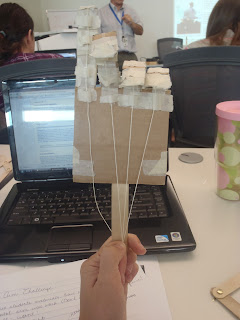Friday, June 29th, 2012
8:00am-9:00pm
The final day at PSTI consisted of a tour of the Johnson Space Center, time at Space Center Houston, a speech by a EVA Instructor, presentations of our week, and a celebration of success.
Our tour of Johnson Space Center was very exciting and we were able to see many pieces of history.
We started at the Mission Control Center. This was different than the historic Mission Control Center we visited on Wednesday. This was a rebuilt center used for Space Shuttle communication.
Next, we went to the Space Vehicle Mockup Facility (SVMF), where they train astronauts in the different vehicles.
We also saw a mockup of R2, the robonaut that I mentioned in a previous post:
(He's under the clear tarp in front of the golf cart looking vehicle)
Next, we were able to visit rocket park and the Saturn V rocket:
After our tour, we returned to our little classroom and learned about EVA Instruction from Allie Battocletti. Allie has the very exciting job of training the astronauts to use tools in space in order to perform EVAs, or Extra Vehicular Activities. This means that she has to work for years with the astronauts to teach them how to use instruments, such as screwdrivers, in space. She then speaks with the astronauts during their mission to talk them through fixing any pieces of the ISS that are necessary.
After Allie's keynote speech, we had a celebration with cake, presents, and certificates!
And for the rest of the day and evening, we each presented our assignments from the week. For the ending assignment, we were to create a presentation that summarized our week at PSTI. The presentation will be shown to classmates at our respective schools to help spread the word of the program.
I used Windows Movie Maker to create my presentation.
Here is my presentation, and it should sum up my thoughts and feelings of spending the week at PSTI. Overall, the time spent in Houston was an amazing learning experience that I will remember for a lifetime. Best of all, it not only benefited me, but it benefited all of the students that I will come to teach during my career.


























































